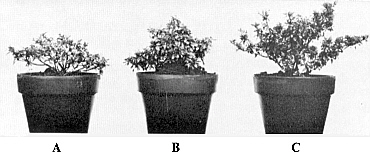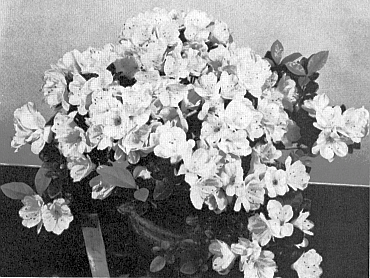QBARS - v23n3 Dwarf Azaleas
Dwarf Azaleas
Robert L. Pryor, Horticulturist
Crops Research Division, Agricultural Research Service
U.S. Department of Agriculture, Beltsville, Md.
The dwarf indica, Rhododendron eriocarpum (Hayata) Nakai, is one of the few recorded instances of dwarf azaleas. It grows wild from Southern Kyushu Mountains and on the island south and west of Kyushu in Japan, through the Ryukyu Islands to Formosa. It grows prostrate on the beach at Yakushima. It blooms at the same time as other forms of indicum, but is more of a dwarf, denser, and slower growing than most. Flowers are lavender, frilled and large. E. H. Wilson regarded eriocarpum as a variety of simsii (1)
Eriocarpum is known in this country by the pink, white, and red 'Gumpo' clones and many others. The Satsuki hybrids which were considered to be dwarf types, were for some time pruned to one stem and only certain shoots were allowed to grow. These were trained in a form to depict a theme, such as a waterfall. It is believed that some of the recent Satsuki azaleas are hybrids derived from crosses between the Indica and dwarf Indica ( R. indicum and R. eriocarpum) on the one hand and the Belgian Indian hybrids on the other. Some of the Satsuki hybrids, 'Banka', 'Taichei', 'Wako', are tetraploids. Plants of 'Banka', and of Wako' were received in 1962 and they are now 86.4 cm high and 63.5 cm wide and would not be considered dwarf.
In 1957 I reported on genetic dwarf azaleas from crosses within the evergreen section (tsutsutsi) R. kaempferi x 'Snow' x 'Maxwelli'. (2) 'Snow' is of the Kurume groups and 'Maxwelli' of the Indicum group. These seedlings were crossed with seedlings of similar parentage, and from these crosses came the first genetic dwarfs of the Kurume type plants. These plants were apparently healthy, but slow growing. Their root systems were extensive and in good condition. Thus the dwarfness was not due to poor root development as is the case with some dwarf fruit trees. These dwarf plants came from crosses of my hybrids and may have inherited some of the dwarfness from Indicum or they may have inherited it from the Kurume group, which was supposed to be prostrate originally. The present upright form Kurumes were supposedly selected out of this prostrate condition.
I have also developed a dwarf form from another type cross. These dwarfs came from crosses of the evergreen ( tsutsutsi ) section x the deciduous ( pentathera ) section. This is one of the results of my attempts to develop a yellow evergreen azalea. These dwarfs came from a cross of my seedling 61-61, which has been backcrossed twice with both parents. The segregation of this cross was 5 tall and 12 semi-dwarf and 34 dwarf. The standard that I use for dwarfness is that the plant must be broader than high and not over 25 cm. in 2 years' growth in the greenhouse. One of the characteristics of the dwarf plants is short branch increments, these being less than 3.7 cm. The second characteristic is direction of growth. Although some are dwarfs only because of short increments of growth (Fig. 40B), others are dwarfs because of horizontal growth and short increments (Fig. 40A). Other forms tend to grow somewhere between horizontal and upright (Fig. 40C). Some dwarf effect could be caused by the very small leaves; even though the plant is well covered with leaves, the total leaf surface is probably much less than the average leaf surface on a normal branch for a nondwarf plant (Fig. 41).

|
| Fig. 40 Dwarf plants showing type of growth. |

|
|
Fig. 41. Non dwarf and dwarf azalea cuttings showing
differing types of leaves |
Dwarfs occur more frequently than I first reported. This may be due in part to my selection of fertile types of dwarfs for crossing. Another reason for this is the intense inbreeding in my attempts to get yellow evergreen azaleas. These section crosses could cause loss of chromosomes or parts of chromosomes, or cause failure to pair. It could be I am more conscious of dwarfs and I am always looking for them (Table 1).
| Table 1 | |||
| Comparison of different types of crosses with original dwarf azalea plant. | |||
| Cross | Dwarf | Semi-dwarf | Tall |
| % | % | % | |
| 236 x 342 1957 | 10.00 | ||
| All crosses 1961 | 30.28 | 22.05 | 47.67 |
| 510 x 610 | 48.38 | 16.13 | 35.49 |
| 499 x 611 | 58.28 | 37.43 | 4.29 |
| 61-61 x 'Prunif' | 66.66 | 23.53 | 9.81 |
| 499 x 'Hino Crimson' | 14.82 | 16.98 | 68.20 |
| 'Hino Crimson' x 499 | 11.32 | 21.12 | 32.44 |
The flowers range in size from 1.9 cm. small to 3.7 cm. medium-large. The colors are: white, pink (shell, medium, and dark), salmon, lavender, orchid, rose, and purple. One is classified spinel red (Ridgeway) but to me this is dark pink. This is not as wide a range of color as is found in Kurume azaleas, but I am trying to correct this deficiency by crossing with some good reds (Fig. 42).

|
| Fig. 42 Typical dwarf azalea in bloom ('Snow Flurry'). |
The leaves can be from .6 x 9 cm. small to 1.5 cm. to 3.5 cm. medium-large. They may be round or oblong, or long and narrow, and they may be smooth or curly (Fig. 41).
The propagation of dwarf azaleas is similar to that of the regular Kurume type azaleas, but it is more difficult because the short increment of growth allows little stem to insert into the rooting medium. Therefore one must take great pains to prevent the rooting medium from drying out. Also, short stems make it difficult to handle in potting after rooting. I am now trying an experiment to speed up growth to see if longer stems and quicker rooting can be induced by improving nutrition and lighting. Gibberellin did not cause these dwarfs to elongate. Dwarf plants can be produced from seed, but they will vary in the amount of dwarfness. From seed, one will get dwarf, semi-dwarf, and tall types in varying ratios. From a commercial standpoint, the semi-dwarfs may be more in demand and become more profitable than the dwarfs. They will grow and propagate faster and easier than the dwarfs. In one year they will probably attain the size of a dwarf grown in the greenhouse for two years or longer. All dwarf azaleas do not bloom in two or three years as do the regular Kurumes. I have had some seven-year-old plants that failed to bloom. We tried to set flower buds on these plants by chemical treatments but this did not work on these dwarfs.
Dwarf azaleas can be used for miniature gardens where space is limited. In this way, one could have a complete range of color in a very small space. Most of these dwarf azaleas would make wonderful plants for rock gardens as they are very compact in height and width. Dwarfs can be used in front of other azaleas to complete a foundation planting. They can also be used under low windows and will never need to be pruned. Dwarf azaleas can also be used in foundation plantings for the low modern type houses. Some of them can also be grown as specimen plants in the landscape. When these dwarfs are used as bonsai, one can avoid the tedious task of pruning the roots to keep them small. Dwarf azaleas are not as readily available as they should be. This is probably due to the slow increase in propagating material resulting in reduced profit. Growers of dwarf azaleas will need to do a job of educating the buying public to the advantages and opportunities of these genetic dwarf plants. Once this is done, the price can be set according to their true worth.
Our dwarf azaleas were originally sent out to seven cooperating nurseries and the National Arboretum. Later the National Arboretum distributed these plants to some of their cooperators. Because I do not carry a stock of these plants, I can only refer your request to a list of growers who may have them. Many prospective purchasers of dwarf azaleas have been disappointed because they have not been able to locate a source of plants. No matter how good a plant is, it will not be a success unless it is available to those desiring to purchase it. The following are the dwarf introductions of the U. S. D. A.
| Little White Lie - Tested as No. 553 | Salmon Elf - Tested as No. 528 | White Nymph - Tested as No. 610 |
| White Doll - Tested as No. 502 | Rose Elf - Tested as No. 485 | Snow Flurry - Tested as No. 611 |
| White Elf - Tested as No. 494 | Pink Elf - Tested as No. 601 | Dainty Rose - Tested as No. 682 |
| Pinkette - Tested as No. 499 | Snow Drop - Tested as No. 602 | Purple Cushion - Tested as No. 688 |
| Leprechaun - Tested as No. 504 | Boutonniere - Tested as No. 604 | Flower Girl - Tested as No. 689 |
| Orchid Belle - Tested as No. 551 | Ping Pong - Tested as No. 606 | My-O - Tested as No. 60-7 |
| Pequeno - Tested as No. 552 | Lavender Elf - Tested as No. 608 |
REFERENCES
l. Wilson, Ernest H. and A. Rehder, 1921, A monograph of azalea rhododendron subgenus anthodendron, The University Press, Cambridge, 219 pp.
2. Pryor, Robert L,. 1957, Dwarf azalea hybrids, Natl. Hort. Mag., Jour. Amer. Hort. Soc., July. pp. 295-302.
3. Lee, Frederic P., 1958, The Azalea Book, D. Van Nostrand Company, Inc., Princeton, N.J., 324 pp.
